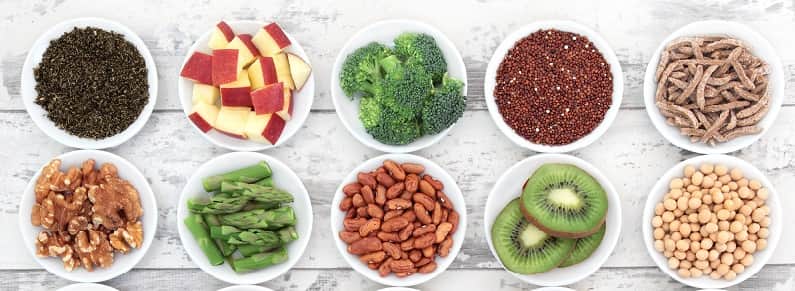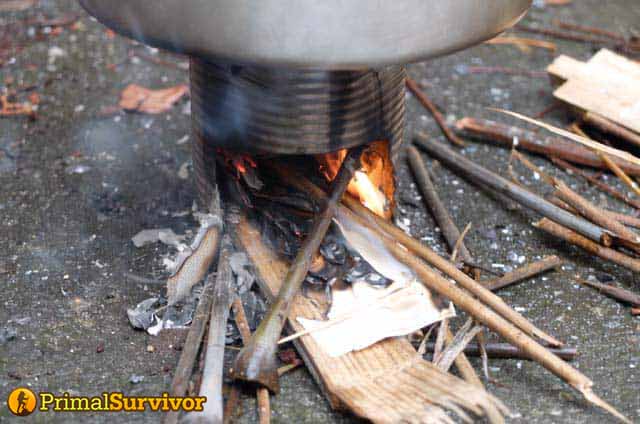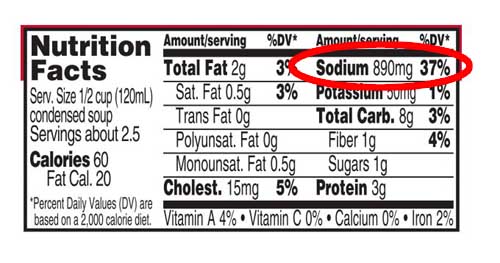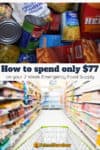FEMA and the Red Cross used to recommend stockpiling 72 hours’ worth of emergency food and supplies. They’ve since updated their recommendation to two weeks’ worth of supplies.
Many people (myself included) think this recommendation is still too low. Natural disasters can wipe out infrastructure for weeks, if not months.
Even if emergency supplies do make it into your area, do you really want to trek out through the disaster aftermath to get supplies? Thus, our Preparedness 101 Guide suggests aiming for at least a 1-month stockpile of emergency supplies.
However, the 2-week emergency supply is an excellent place to start.
As you can see from this shopping list, it doesn’t even cost that much to get 2 weeks’ worth of food and water.
How Much Emergency Food for 2 Weeks?
The World Health Organization recommends 2,100 calories of food per day. This is how much an average person doing light activity would require.
I think that the 2,100 figure is a bit high. During disasters where you hunker down at home, you will probably be sitting around a lot. When you aren’t active, you don’t need a lot of calories.
However, the disaster may wipe out your heating. You’d then need a lot of calories to keep yourself warm.
Likewise, food can be a great comfort during emergencies. Even if you aren’t needing food, preparing a meal and snacking can keep the family calm.
So, the 2,100 calorie amount is what I’ll be using here.
2,100 calories x 14 days = 29,400 calories
Calorie Breakdown by Meal
I’ve seen emergency food supply lists that look something like “5lbs of rice, 5lbs of dry beans, and granola bars.”
Yes, this food would sustain you. But eating beans and rice for almost every meal is going to sap your morale (not to mention the logistical problems of cooking beans and rice every day…).
Instead, when making your emergency food shopping list, think about what you will eat for breakfast, lunch, dinner, and snacks.
Here’s how the calories break down per meal.
Breakfast:
- 400 calories
- x14 days = 5,600 calories
Lunch:
- 600 calories
- x14 days = 8,400 calories
Dinner:
- 700 calories
- x14 = 9,800 calories
Snacks:
- 2 snacks at 200 calories each
- x14 = 5,600 calories
What about Nutrients?

During short-term emergencies, nutrition isn’t exactly your primary concern. However, nutrition could become very important if an emergency lasts longer than a week.
Emergencies bring about all sorts of conditions where you’d want a healthy diet. For example, if flooding fills the streets with sewage, you’d want to make sure your immune system is strong. Likewise, if you get injured during an event like an earthquake, you’d want nutritious food to help you heal faster.
The WHO set these guidelines for emergency food planning:
Protein:
Protein should represent a MINIMUM of 10% to 12% of your calories. For 14 days, that means 3,528 calories should come from protein.
One gram of protein has 4 calories. So, that means you need at least 52g of protein per day. Over 14 days that equals 882g of protein.
Fat:
Fat should represent AT LEAST 17% of your daily calories. For 14 days, that means 4,998 calories from fat.
One gram of fat has 9 calories. That means you need at least 40g of fat per day. Over 14 days, you need at least 555grams of fat.
Note:
*Fat requirements for young children are much higher; 30-40% of calories. For pregnant and lactating women, the requirement is at least 20%.
Micronutrients:
Micronutrients – such as vitamins, iron, zinc, etc. – are crucial for your 2-week emergency food supply. You don’t want to eat just peanut butter and crackers every day (even though this would meet the protein/fat requirements).
It’s very time-consuming to calculate micronutrients in your emergency food supply. Instead, I would recommend this approach:
- Make sure you include fruits and vegetables in your emergency food.
- Consider stockpiling a multivitamin or powdered vitamin drink mix. (See how to store vitamins long-term.)
Tips for Planning Your 2 Week Emergency Foods Supply
There are many different ways to go about building your emergency food stockpile. For example, you can buy emergency food kits that contain freeze-dried meals. Just add water to the meals, and you are done.
These kits are the most convenient way to go. However, they can be pricey. If you buy in bulk, though, you’ll get much better deals. See our picks for the best emergency food brands here.
For this shopping list, I decided only to use cheap foods found in the supermarket. Here are some notes about the emergency foods.
Think Meals, Not Foods
Try not to just buy a bunch of canned foods for your emergency supply. You’ll end up with a zillion cans of corn and nothing to eat it with.
Instead, think about what you would eat for a meal. Then get the ingredients for these meals. Some sample emergency meals are listed below.
No Jars
Jars will break during a lot of emergencies (earthquakes, for example). Thus, jarred food isn’t a good option for your emergency stockpile. Instead, I only chose foods in cans, pouches, or boxes.
Breakfast and Lunches Should Require No Cooking
During emergencies, it’s unlikely that your stove will be working. So, while oatmeal and canned soup might taste better when heated up, you might want to eat them cold to save on fuel.

Choose Quick-Cooking Dinners
You’ll notice that there aren’t any dry beans on this shopping list! That’s because dry beans take 45+ minutes to cook. Bear in mind that you probably won’t have a refrigerator during a disaster situation, so you can’t exactly cook large batches of beans to eat over the next few days.
All of the emergency dinner foods do require cooking. However, they can be cooked relatively quickly. Instant mashed potatoes don’t even need to be cooked. You can just add water and wait. You can even cut down the cooking time on pasta by pre-soaking it.
*You’ll still need to consider how you’ll cook food during an emergency situation. Here are some options for cooking without power.
Avoid Sodium Overload
It’s good to include instant meals like canned soups in your emergency food stockpile. However, it’s important to remember that these foods are generally loaded with sodium.
In the short term, this isn’t going to matter much. But, over a long-term emergency, you’d want foods with less sodium. Hence, I limited the instant meals to lunch and made a “prepared meal” for the dinners.

Some Foods Will Need to Be Repackaged
Canned foods are great for starting your emergency food supply. Cans are virtually indestructible and will last forever. However, this isn’t the case with many “non-perishable” foods.
Foods like crackers, croutons, pasta, and boxed rice can last a very long time. But the food won’t necessarily survive a disaster.
What if flood water gets to them? What if the boxes get smashed open by hurricane debris?
At the very least, you should keep these survival foods in a bucket. It is even better to repackage the foods in Mylar bags with oxygen absorbers and then put them in a bucket. This method will keep your food safe for 15+ years!
More on storing food in Mylar bags here.
Rotate Foods
If you don’t repackage foods like pasta or cereal into Mylar bags, then you’ll need to rotate through them. Make a plan for this, such as checking on your food supply every 6 months.
Make a Spreadsheet
As you buy foods for your emergency food supply, list them in a spreadsheet with the number of calories (and fat/protein content, too, if you feel inclined).
This will help you track how long your food supply will last.
Remember to update your spreadsheet if you rotate through your supply!
Sample DIY Emergency Meals
Here are some meals that you could make based on the shopping list I’ve created.
Breakfasts:
- Oatmeal with dried fruit and milk
- Cereal with milk
Lunches:
- Various canned soups with croutons or crackers
- Peanut butter and crackers
Dinners:
- Rice with beans, corn, seasonings, and cheese from powder mix
- Pasta with tuna, tomato, and cheese from powder
- Pasta with chicken, tomato, carrots, and cheese from powder
- Mashed potatoes with chicken and instant gravy
Emergency Food Shopping List
Here’s the shopping list of emergency food for a two-week supply. Prices were taken from Amazon, Dollar General, and Walmart, selecting generic brands and bulk packs for the best value.
Link to Amazon grocery department.
Note that this emergency food shopping list is mainly for inspiration. I want to show that you don’t need to spend a lot of money to get prepared.
Keep a spreadsheet of the emergency foods you got. As you add to your stockpile, you can update it, so you know how many days’ worth of food you have.
Check out our Food Storage Workbook if you want an easy way to plan your emergency food supply successfully.



Thank you for this info. It’s very helpful and simple.
Is this list for one person, or two?
maybe this is a dumb question but is this for one person?
Yes this is for 1 person assuming 2100 calories per day.
Could you offer a download of a spread sheet for tracking one’s food storage supplies? Thanks.